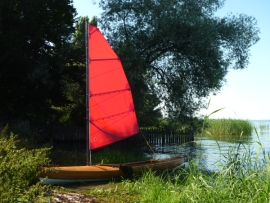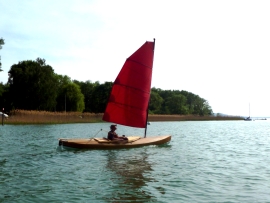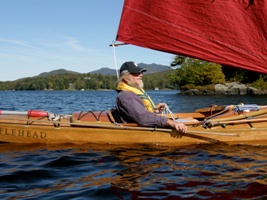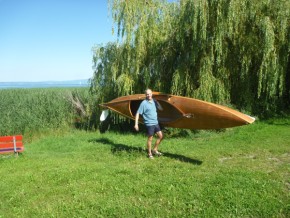| Language and Social Media |  |
 |
 |
 |
BUFFLEHEAD Sailing Canoe Features
 You may notice that this design just looks right the first first time you lay eyes
on it. This canoe has the look of balance, because the hull, deck and
rig all harmonize well together. It is functional,
with no extra frills keeping it simple and pure. BUFFLEHEAD is as relaxed as her skipper, in a spacious cockpit on a
comfortable seat, sheet and rudder in hand, as close to wind and the water as
possible. Most modern designs look tense, impatient on their mooring, as if they cannot wait to plow the water at 20
knots as soon as the moorings are released.
This boat fits in with nature, like she belongs here and now. She is Zen, radiating an atmosphere of meditative
calmness. Unpretentious, functional, consistent, quite simply beautiful.
You may notice that this design just looks right the first first time you lay eyes
on it. This canoe has the look of balance, because the hull, deck and
rig all harmonize well together. It is functional,
with no extra frills keeping it simple and pure. BUFFLEHEAD is as relaxed as her skipper, in a spacious cockpit on a
comfortable seat, sheet and rudder in hand, as close to wind and the water as
possible. Most modern designs look tense, impatient on their mooring, as if they cannot wait to plow the water at 20
knots as soon as the moorings are released.
This boat fits in with nature, like she belongs here and now. She is Zen, radiating an atmosphere of meditative
calmness. Unpretentious, functional, consistent, quite simply beautiful.
When the canoe learned to sail
 Canoe sailing has some history. Some 150 years ago, it was absolutely
en vogue among the young gentlemen. The
sailing canoe was not only used for entertainment between supper and tea but also for expeditions:
John MacGregor took long
spectacular trips along the coast and wrote several books on that
subject - until, around 1900, travelling by bicycle on the then idyllic streets was invented, and the sailing canoe went
out of fashion.
Canoe sailing has some history. Some 150 years ago, it was absolutely
en vogue among the young gentlemen. The
sailing canoe was not only used for entertainment between supper and tea but also for expeditions:
John MacGregor took long
spectacular trips along the coast and wrote several books on that
subject - until, around 1900, travelling by bicycle on the then idyllic streets was invented, and the sailing canoe went
out of fashion.
BUFFLEHEAD's design was heavily influenced by these boats, but she is built with today's materials and
state-of-the art building techniques.
A "50-50"-canoe...
 Hugh Horton is the Designer of the BUFFLEHEAD sailing canoe. His designs are the result of his
actual experience.
Hugh has travelled several thousand miles in a variety of small boats over decades. He designed this one as his perfect
escape vehicle. This design is referred to as a "50-50-canoe; sail when you can, paddle when you must". Accordingly,
this canoe has plenty of buoyancy with its full bow and stern sections to be a worry-free sailor. It's wide enough
to allow ample sail area and narrow enough to be paddled with a double paddle. The battened
sail on the short mast and
spars has a perfect shape and can be reefed several times. When paddling becomes necessary the whole rig is easily stowed
inside the boat. BUFFLEHEAD has payload allowances for camping gear and food for one or two weeks. Or the spacious cockpit
can carry an additional passenger for a lovely day cruise.
Hugh Horton is the Designer of the BUFFLEHEAD sailing canoe. His designs are the result of his
actual experience.
Hugh has travelled several thousand miles in a variety of small boats over decades. He designed this one as his perfect
escape vehicle. This design is referred to as a "50-50-canoe; sail when you can, paddle when you must". Accordingly,
this canoe has plenty of buoyancy with its full bow and stern sections to be a worry-free sailor. It's wide enough
to allow ample sail area and narrow enough to be paddled with a double paddle. The battened
sail on the short mast and
spars has a perfect shape and can be reefed several times. When paddling becomes necessary the whole rig is easily stowed
inside the boat. BUFFLEHEAD has payload allowances for camping gear and food for one or two weeks. Or the spacious cockpit
can carry an additional passenger for a lovely day cruise.
 BUFFLEHEAD is so light that you can carry it over your shoulder to the water; it is considerably lighter than a
decked fiberglass canoe off the shelf. It is easy to cartop. You can sleep comfortably inside the hull, with a
cockpit tent above you. When not in use, you can stow BUFFLEHEAD in a garage
up in the rafters or hang on the wall, she doesn't take up much space. Canoes, generally, need neither license nor are
they taxed. Even with all these features the very
functional design does not look overconstructed. In fact, it seems like Hugh Horton on his journeys did not engineer
the design with formulas and calculations but rather meditated on it and allowed every part of the boat to find its
natural place and its fairest shape.
BUFFLEHEAD is so light that you can carry it over your shoulder to the water; it is considerably lighter than a
decked fiberglass canoe off the shelf. It is easy to cartop. You can sleep comfortably inside the hull, with a
cockpit tent above you. When not in use, you can stow BUFFLEHEAD in a garage
up in the rafters or hang on the wall, she doesn't take up much space. Canoes, generally, need neither license nor are
they taxed. Even with all these features the very
functional design does not look overconstructed. In fact, it seems like Hugh Horton on his journeys did not engineer
the design with formulas and calculations but rather meditated on it and allowed every part of the boat to find its
natural place and its fairest shape.
... for virtually unlimited use
It is unbelievable how versatile the boat is. Do you dream of an afternoon on the Lake Constance, a weekend on the Swiss
Walensee followed by a descend through the Linthkanal, a month holiday on the East German lakes or the lagoons on the
Baltic coast, a trip on the Loire, Rhone or Danube, along the Italian or Croatian coastline or the coast of Cape Horn?
Treated with excellent seamanship, this boat can be used for all these trips like no other one. BUFFLEHEAD offers more
fun for less money, more seaworthiness per kilo than any other boat.